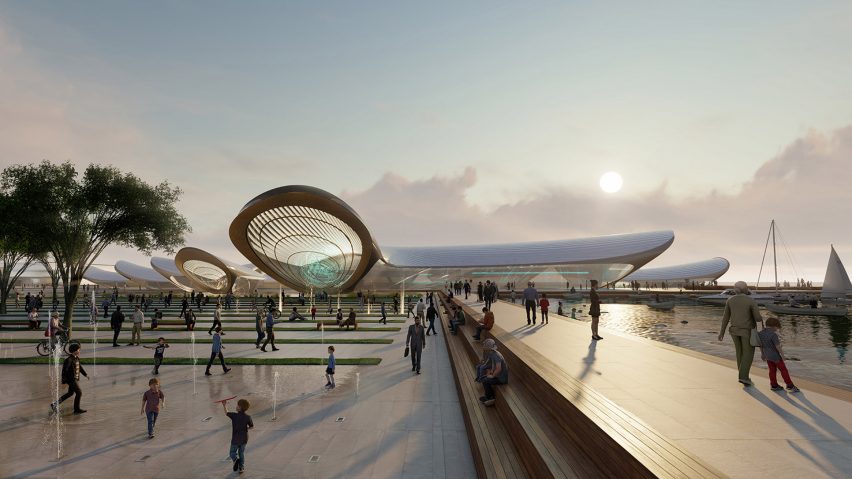Dismantable buildings form the core of Zaha Hadid Architects' proposed masterplan for Odesa's world expo bid, which would offer participating nations a kit of parts to build their own pavilions.
Zaha Hadid Architects' masterplan for Ukraine's World Expo 2030 bid is focused on four large central pavilions, which would provide 80,000 square meters of exhibition space for the event.
Once the expo is over, these would be used to hold trade fairs and events alongside a new conference centre on the site of the expo – the Khadzhibey estuary, located 20 minutes away from Odesa's historic old town.
Zaha Hadid Architects' design for the site would see the studio create modular national pavilions made from a choice of kit-of-parts, which the studio said would allow each country to "individually reinterpret the over-arching theme of Expo 2030 via their country's unique cultural expression".
Each of the modular components would make up around 25 per cent of a pavilion's standard 1,600 square-metre site and could be combined with various other modular elements. Countries would be able to choose the modules and design their pavilions using a digital configurator tool.
Facades would be designed from a variety of options with "the lowest possible carbon impact", said Zaha Hadid Architects.
The expo site itself would have a main boulevard that would connect all expo areas, as well as a series of plazas. National pavilions would be located south of the boulevard while a coastal "eco-park" would sit on the Khadzhibey estuary to the north.
Either end of the main boulevard would hold services, accommodation and logistics for visitors, staff and participants.
Odesa Expo 2030 was designed "with legacy in mind" and would be the first world expo to be hosted in eastern Europe. Afterwards, the national pavilions would be dismantled and could be used as civic buildings throughout Ukraine or brought back home by the participating countries.
The modules were specifically designed to be able to fit onto the shipping barges that are used for transportation on the nearby Black Sea, Azov Sea and Dnipro River.
The site surrounding the remaining buildings – the conference centre and central pavilions – would be "returned to nature" through the re-establishment of wetlands.
Though the ongoing war in Ukraine was not mentioned by the architecture studio, it said that the masterplan aims to minimise the use of concrete by using "recycled materials from damaged and demolished structures throughout southern Ukraine".
Photovoltaics would be added to all roofs and the Expo 2030 micro-grid would be connected to wind turbines, which would supply the energy needed for the expo itself but also create renewable energy for the local community.
"In a city that has always been multinational and multicultural, a city of diversity with ancient connections throughout the world, when you visit Ukraine and our Odesa in 2030, you will feel the power and culture of not just one country and one city… you will feel the potential of all humanity," said president of Ukraine Volodymyr Zelenskyy.
Odesa is one of four cities competing for the Expo 2030, with Busan in South Korea, Rome in Italy and Riyadh in Saudi Arabia, also having submitted bids to host the event.
A decision as to which city wins will be announced in November 2023.
Ukraine has been badly affected by the war, which began when Russia invaded the country on 24 February. Since then, Russian shelling has destroyed and damaged a number of culturally significant buildings and the crisis has displaced millions of people.
The country's postal service recently released a stamp celebrating the "titanic efforts of its armed forces", while a studio whose Kyiv office was damaged in a Russian missile attack has vowed to rebuild it.
The latest world expo to take place was the Expo 2020 Dubai, which was held in 2021 after being postponed due to the coronavirus pandemic. The event featured a number of pavilions designed by well-known architects, including a Sustainability Pavilion by Grimshaw Architects that was criticised for its "unnecessary emissions."

